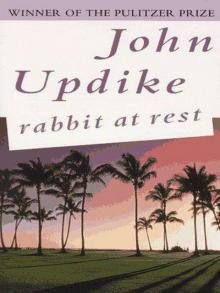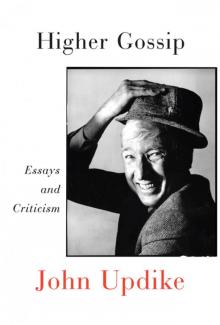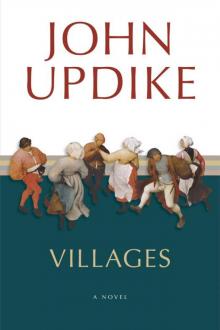- Home
- John Updike
Hub Fans Bid Kid Adieu: John Updike on Ted Williams Page 3
Hub Fans Bid Kid Adieu: John Updike on Ted Williams Read online
Page 3
Understand that we were a crowd of rational people. We knew that a home run cannot be produced at will; the right pitch must be perfectly met and luck must ride with the ball. Three innings before, we had seen a brave effort fail. The air was soggy, the season was exhausted. Nevertheless, there will always lurk, around the corner in a pocket of our knowledge of the odds, an indefensible hope, and this was one of the times, which you now and then find in sports, when a density of expectation hangs in the air and plucks an event out of the future.
Fisher, after his unsettling wait, was low with the first pitch. He put the second one over, and Williams swung mightily and missed. The crowd grunted, seeing that classic swing, so long and smooth and quick, exposed. Fisher threw the third time, Williams swung again, and there it was. The ball climbed on a diagonal line into the vast volume of air over center field. From my angle, behind third base, the ball seemed less an object in flight than the tip of a towering, motionless construct, like the Eiffel Tower or the Tappan Zee Bridge. It was in the books while it was still in the sky. Brandt ran back to the deepest corner of the outfield grass, the ball descended beyond his reach and struck in the crotch where the bullpen met the wall, bounced chunkily, and vanished.
Like a feather caught in a vortex, Williams ran around the square of bases at the center of our beseeching screaming. He ran as he always ran out home runs—hurriedly, unsmiling, head down, as if our praise were a storm of rain to get out of. He didn’t tip his cap. Though we thumped, wept, and chanted “We want Ted” for minutes after he hid in the dugout, he did not come back. Our noise for some seconds passed beyond excitement into a kind of immense open anguish, a wailing, a cry to be saved. But immortality is nontransferable. The papers said that the other players, and even the umpires on the field, begged him to come out and acknowledge us in some way, but he refused. Gods do not answer letters.
Every true story has an anticlimax. The men on the field refused to disappear, as would have seemed decent, in the smoke of Williams’ miracle. Fisher continued to pitch, and escaped further harm. At the end of the inning, Higgins sent Williams out to his left-field position, then instantly replaced him with Carroll Hardy, so we had a long last look at Williams as he ran out there and then back, his uniform jogging, his eyes steadfast on the ground. It was nice, and we were grateful, but it left a funny taste.
One of the scholasticists behind me said, “Let’s go. We’ve seen everything. I don’t want to spoil it.” This seemed a sound aesthetic decision. Williams’ last word had been so exquisitely chosen, such a perfect fusion of expectation, intention, and execution, that already it felt a little unreal in my head, and I wanted to get out before the castle collapsed. But the game, though played by clumsy midgets under the feeble glow of the arc lights, began to tug at my attention, and I loitered in the runway until it was over. Williams’ homer had, quite incidentally, made the score 4–3. In the bottom of the ninth inning, with one out, Marlan Coughtry, the second-base juggler, singled. Vic Wertz, pinch-hitting, doubled off the left-field wall, Coughtry advancing to third. Pumpsie Green walked, to load the bases. Willie Tasby hit a double-play ball to the third baseman, but in making the pivot throw Billy Klaus, an ex–Red Sox infielder, reverted to form and threw the ball past the first baseman and into the Red Sox dugout. The Sox won, 5–4. On the car radio as I drove home I heard that Williams, his own man to the end, had decided not to accompany the team to New York. He had met the little death that awaits athletes. He had quit.
TED WILLIAMS, 1918—2002
TED took his time leaving this world, and he’s not quite out of it yet. He is cryonically frozen in Arizona, drained of blood and upside down but pretty much intact,13 waiting for whatever resurrection technology can eventually produce. This bizarre turn in the Williams saga, which two of his three children claim to be by his own wish, does accord with a general perception among his admirers that there was something very precious about him, worth preserving if at all possible. To those of us who saw him at the plate, he seemed the concentrated essence of baseball: a tall, long-necked man wringing the bat handle and snapping the slender implement of Kentucky ash back and forth, back and forth in his impatience to hit the ball, to win the battle of wits and eye-hand coördination that, inning after inning, pits the solitary batter against the nine opposing men on the field.
He came from California to a dowdy New England metropolis with too many newspapers, and was instant news. The Williams excitement had to do with his personality as well as his prowess; the former was as complex as the latter seemed transparent. He was, like Ty Cobb, a deprived man, hungry for greatness; but, unlike Cobb, he had a sweet smile. Boston wanted to love the Kid, but he was prickly in its embrace. He was hot-tempered and rabbit-eared and became contemptuous of sportswriters and too proud to tip his hat after hitting a home run. And the teams he ornamented didn’t win all the marbles; the spectacular Sox of 1946 lost the World Series, and, after that, pennants just slipped away, while Williams sulked, spat, threw bats, and threatened retirement. In the end, the city loved him all the more because the relationship had proved so complex; “some obstacle,” as Freud wrote, “is necessary to swell the tide of libido to its height.” No sports figure—not Bobby Orr or Larry Bird or Rocky Marciano—had a greater hold over the fans of New England than Ted Williams.
From the generous team owner Tom Yawkey he received top dollar—what now seems a paltry $125,000 a season—but he was one of the few ballplayers who all by themselves brought people out to the park. In 1957 the third-place Red Sox drew 1,187,087, and the sportswriter Harold Kaese wrote, “The Red Sox drew 187,087 and Ted Williams drew the other million.”
He had talent: a big man with great eyes. He had intensity, and nobody practiced longer or thought harder about the niceties of the little war between pitchers and hitters. But he also had poignance, a flair for the dramatic. His career abounds with storybook hits, with thunder that remained etched on the air. But behind that thunder stood a multitude of hot days and wearisome nights, games that didn’t mean much beyond the moment, to which Williams brought his electric, elegant best. We loved him because he generated excitement: he lifted us out of our own lives and showed us, in the way he stood up at the plate, what the game was all about.
For most of two decades—1939 to 1960, with time out for service in two wars—he was the main reason that people went to Red Sox games in Boston.14 In those decades he made the American League all-star team eighteen times and had the highest overall batting average, .344. The decades since his retirement, crowded with careers uninterrupted by national service and bolstered by a livelier ball and new techniques of physical conditioning, have seen him slip lower in the record lists; his home-run total of 521, third behind Babe Ruth and Jimmy Foxx in 1960, is now tied for twelfth, with Frank Thomas and Willie McCovey. His lifetime on-base percentage of .482 still stands as the major-league record, though the phenomenal Barry Bonds twice had better seasons (.609 in 2004, .582 in 2002) than Williams’ best (.551 in 1941). And in the four years from 2001 to 2004, Bonds three times exceeded a total in which Williams for decades had ranked only second to Ruth, that of walks drawn in a single season.
One Williams statistic, however, gathers luster rather than dust as the years go by—his season average, in 1941, of .406. For nearly seventy years he has remained the last of the .400 hitters, his .406 nailed down in a double-header in Philadelphia that he could have sat out; he was batting .39955, which rounds up to .400, but he elected to play and went six for eight in the two games. In fact, he hit .400 in three seasons, counting the truncated bits of 1952 and ’53, when he was drafted into the Korean War: four hits in ten appearances before he reported for duty, and thirty-seven in ninety-one when he came back the following year. In 1957, he hit .388, including four home runs in as many official at-bats when a bout of flu had reduced him to a pinch-hitter. That year, and then the next, he became the oldest man ever to win a batting title. In the two preceding seasons he had the highest average in
the league, but injuries and illness kept him from getting four hundred at-bats. These latter seasons, when he was playing for indifferent teams with an accumulated, underpublicized burden of aches and pains, cemented his claim to be called the greatest hitter of his era, an era that included Joe DiMaggio and Stan Musial.
Yet, when an athlete or opera singer or exhilarating personality dies, it is the live performance we remember, the unduplicable presence, the shimmer and sparkle and poignance, perceived from however far back a seat in the audience. Williams’ swing was a grand motion, never a lunge or a hasty fending, with a graceful follow-through that left his body yearning toward first base. It was long, much longer than Ruth’s (how did Ruth hit all those home runs out of that chop?), and beautiful the way Sam Snead’s swing was beautiful, all body parts working together and the ball just an incident in the course of the arc. Pop the hips was his theory, just like a golf pro’s; but the golf ball isn’t coming at you at ninety miles an hour with english on it, out of a mess of billboards. There was something very pure and uncontrived about the way he hit. He said he swung slightly upwards, to compensate for the pitcher being raised above the batter; but it didn’t look that way. His swing looked level. It took up a lot of space and seemed fully serious in its sweep.
At six foot three, Williams was one of the taller men on the field, and we in the crowd brought with us an awareness, like the layer of cigarette smoke that used to hover under the lights, of his dangerous rage to excel—of his on-field temper tantrums, his spats with the press, his struggles with marriage, and his failure, as the years ground on, to make it back to a World Series and redeem his weak performance in 1946. Success and failure in baseball are right out there for all to see; so is focus on the assigned task. Williams’ body language declared that he wanted to be the best, that this was more than a game or a livelihood for him. He was paid, toward the end of his career, a record (believe it or not) $125,000 a season, and after his worst season, his only sub-.300 season, in 1959, he asked management for a pay cut.
In the long stretch after 1946, as the excellent Sox teams of the Forties yielded to the mediocre Fifties teams, Ted kept up the show. The intensity, the handsome lankiness, the electric hum as the line-up worked around to his appearance were summer constants. Fenway Park, in those days, was not always full; the advance-ticket crowds from Maine and New Hampshire hadn’t yet materialized in that thinner era, which took its baseball as a homely staple, without luxury boxes. On an impulse, I bought in for a few dollars to his last game, and the park was two-thirds empty. I was moved to write about the events of that game, in part because his departure, taking with it the heart of Boston baseball, had been so meagerly witnessed.
With retirement he became what William Butler Yeats called a “smiling public man.” The stern, temperamental baseball perfectionist dropped his concentrated air of work-in-progress and joined us on the sidelines. He managed a team, the Washington Senators, with a middle-aged patience. He faithfully showed up at Red Sox spring training and was generous—in a voice bellicosely loud in part because flying jets in Korea had half-deafened him—with advice and praise, to friend and foe alike. He fished with the same obsessive passion with which he had analyzed the geometry of the strike zone. He continued to serve as the symbol of the Jimmy Fund, which he had animated with a thousand personal encouragements of cancer-stricken children. He used his Baseball Hall of Fame acceptance speech to plead for the admission of the great players of the old Negro leagues; in a bygone era when the majors brimmed with unreconstructed rednecks, he had welcomed baseball’s integration and befriended the Red Sox’s belated black recruits.
He drew closer to his three children, and the public drew closer to him. The new journalism generated interviews in which his language, long held to the locker room, was revealed as bumptiously obscene and youthfully enthusiastic. Compared now with DiMaggio, he appeared more open, less wary, with nothing to hide and everything to share, as the darkness of failing eyesight, the helplessness of strokes and daily dialysis and the desperate operations that the wealthy and famous must endure closed in. On two occasions his aging body was hauled to Boston and he made a show of tipping his cap to the crowd; but we didn’t need that. The crowd and Ted had always shared what was important, a belief that this boys’ game terrifically mattered.
A NOTE ABOUT THE AUTHOR
John Updike was born in 1932, in Shillington, Pennsylvania. He graduated from Harvard College in 1954, and spent a year in Oxford, England, at the Ruskin School of Drawing and Fine Art. From 1955 to 1957, he was a member of the staff of The New Yorker, and after 1957 lived in Greater Boston, never more than an hour’s drive from Fenway Park. He was the author of more than sixty books, including novels and collections of short stories, poems, and criticism. His fiction won the Pulitzer Prize, the National Book Award, the American Book Award, the National Book Critics Circle Award, the PEN/Faulkner Award, and the Howells Medal, among other honors. His only other book of sportswriting is Golf Dreams. John Updike died in January 2009.
“Ted Williams as of 1986”
From Sport Magazine
and Odd Jobs
Ted Williams, as of 1986
HE APPEARS in television commercials now, but seems sheepish saying the lines, a leathery-faced old gent whose eyes look a bit menacing even as they strive to twinkle. For a long time, as Joe DiMaggio urbanely peddled coffee machines on the little round-cornered screen, Ted Williams was conspicuous for his absence from the public eye, save when he peeped out of the dugout while managing the overlookable Senators/Rangers of 1969–72. The last time he appeared in an old-timers game at Fenway Park, he made a valiant shoestring catch but could hardly get his bat on the ball, though he was given an extra, out-of-turn “ups.” His recent interviews are eerily good-natured, as he blesses the newest version of the Red Sox or the newest unsuccessful attempt—by Rod Carew, George Brett, Wade Boggs—to supplant him as the last .400 hitter.
It is now forty-five years since the cocky, lanky kid from San Diego closed out the season with an average of .406. That statistic has emerged from the shadows of 1941 (when Jolting Joe hit in fifty-six straight games and the Japanese hit Pearl Harbor) to become Williams’s most famous feat, the tarnish-proof polish on the silver of his reputation; but it really is the fifteen postwar years of his career, harassed though they were by injuries, sportswriters, boos, disappointments on the field and marital misadventures off it, the Korean War, and the Williams Shift, that established him as a steady wonder, the best hitter of his era and a kind of link between the highly technological players of today and the rough-hewn statistical giants (Cobb and Hornsby, Sisler and Ruth, Napoleon Lajoie and Shoeless Joe Jackson) of a virtually mythological time whose living witnesses are increasingly few.
By 1986 more than a generation of baseball fans and players has grown up who never saw Williams play—never saw him hit, one should say, for though he was a dutiful outfielder with a strong arm when young, and a baserunner who went through the motions and stole as much as four bases a season, he always looked as if his heart was at the plate, which it was. Hitting was his thing, and even when the Red Sox, in the late Forties, had stars at almost every position, the crowd waited through the line-up to see Ted’s turn at bat. A tall man with broad shoulders, he towered over the plate, and seemed greedy while there, wringing the bat handle with his fists, switchily moving it back and forth as if showing the pitcher exactly where he wanted the poor ball placed. He had a wide stance with nothing contorted about it, no peek-a-boo around his shoulder like Stan Musial, no funny work with the feet like so many of today’s overcoached fusspots.
In Williams’s day baseball still savored of its cow-pasture beginnings—the East still held a few actual cow pastures—and the uniform was baggy, and no hitter wore a golf glove, let alone two, and the batting helmet was viewed (at least by Williams) as an encumbering innovation. His swing was long, much longer than Ruth’s (how did Ruth hit all those home runs out of that chop?), and beauti
ful the way Sam Snead’s swing is beautiful, all body parts working together and the ball just an incident in the course of the arc. Pop the hips was his theory, just like a golf pro’s; but the golf ball isn’t coming at you at ninety miles an hour with English on it, out of a mess of billboards. He says he swung slightly upwards, to compensate for the pitcher being raised above the batter; but it didn’t look like that. His swing looked level. The first Williams homer I remember, seen from the bleachers of old Shibe Park in Philadelphia, was a line drive that was still rising as it cleared the right-field fence. There was something very pure and uncontrived about the way he hit, and though his power totals and his averages are not the best, nobody ranks so high in both departments of hitting. To put it another way, nobody else with over five hundred homers (521) has so high a lifetime average (.344). He was the strongest good hitter, or the finest-tuned slugger, the game has seen. Temperamental and injury-prone, he yet showed an impressive durability; he won his fifth batting championship in 1957 by hitting .388, and won his sixth the next year at the age of forty.

 Picked-Up Pieces: Essays
Picked-Up Pieces: Essays Bech: A Book
Bech: A Book Roger's Version: A Novel
Roger's Version: A Novel Seek My Face
Seek My Face The Carpentered Hen
The Carpentered Hen Pigeon Feathers: And Other Stories
Pigeon Feathers: And Other Stories Rabbit Is Rich
Rabbit Is Rich The Afterlife: And Other Stories
The Afterlife: And Other Stories Rabbit at Rest
Rabbit at Rest The Witches of Eastwick
The Witches of Eastwick Gertrude and Claudius
Gertrude and Claudius Bech Is Back
Bech Is Back Hub Fans Bid Kid Adieu: John Updike on Ted Williams
Hub Fans Bid Kid Adieu: John Updike on Ted Williams Marry Me: A Romance
Marry Me: A Romance Museums and Women: And Other Stories
Museums and Women: And Other Stories My Father's Tears and Other Stories
My Father's Tears and Other Stories Collected Poems, 1953-1993
Collected Poems, 1953-1993 Trust Me: Short Stories
Trust Me: Short Stories Odd Jobs: Essays and Criticism
Odd Jobs: Essays and Criticism Rich in Russia
Rich in Russia Higher Gossip: Essays and Criticism
Higher Gossip: Essays and Criticism The Widows of Eastwick
The Widows of Eastwick In the Beauty of the Lilies
In the Beauty of the Lilies Rabbit, Run
Rabbit, Run The Early Stories: 1953-1975
The Early Stories: 1953-1975 Rabbit Redux
Rabbit Redux S.
S. Brazil
Brazil Toward the End of Time
Toward the End of Time The Centaur: A Novel
The Centaur: A Novel Assorted Prose
Assorted Prose Memories of the Ford Administration
Memories of the Ford Administration Terrorist
Terrorist Couples: A Novel
Couples: A Novel Bech at Bay
Bech at Bay The Music School: Short Stories
The Music School: Short Stories Villages
Villages S
S Roger's Version
Roger's Version Pigeon Feathers
Pigeon Feathers Higher Gossip
Higher Gossip Rabbit Redux r-2
Rabbit Redux r-2 Memories of the Ford Administration: A Novel
Memories of the Ford Administration: A Novel The Centaur
The Centaur Marry Me
Marry Me Picked-Up Pieces
Picked-Up Pieces Bech
Bech Rabbit Remembered
Rabbit Remembered Trust Me
Trust Me The Early Stories
The Early Stories Odd Jobs
Odd Jobs The Centaurus
The Centaurus The Afterlife
The Afterlife The Music School
The Music School Museums and Women
Museums and Women Couples
Couples